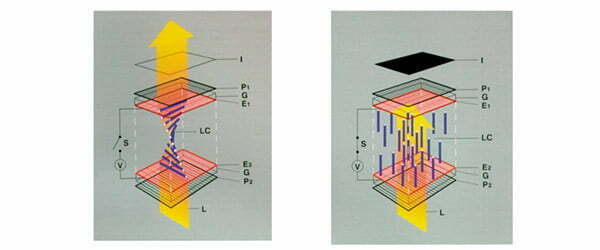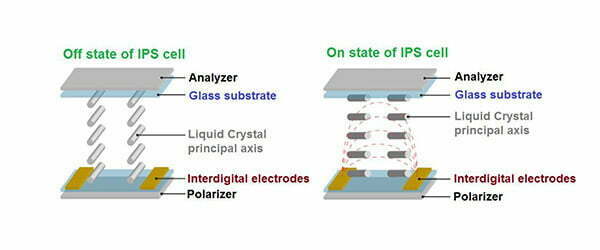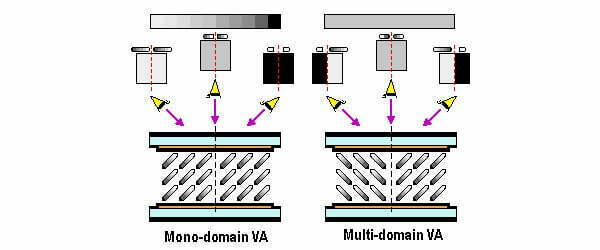When most users purchase a new screen, they are likely to look at three specifications; refresh rate, price, size, and resolution. In fact, a screen’s affordability, size, and pixel density may be enough to convince the average user to purchase it.
However, gamers tend to be more pedantic about their monitors. Every characteristic counts, from the response times to the display panel technology.
In this guide, we will be discussing the latter. There are several different display panel types out there. You may have come across TN, IPS, PLS, AHVA, eIPS, OLED, VA, etc.
What is The Difference between TN, IPS, and VA
The main display panel types we need to look at are TN, IPS, and VA. Thus, this guide will explore the differences between these display panel technologies and ultimately help you decide which one is the best one for you.
TN – Twisted Nematic Panels
People often misunderstand the relationship or differences between LED and LCD screens.
LCDs (light crystal displays) are types of LED (light-emitting diode) displays. This distinction is important.
TN (twisted nematic) panels are considered one of the most important innovations in LCD technology.
They made LCD screens more accessible and cheaper to make. They would eventually quicken the obsoletion of display standards such as the CRT screen.
The simplest example of a widely used TN-based LCD screen is the modern calculator screen. In addition to this, your old-school Casio digital watch face most likely uses a TN display.
The original TN cell was invented in the early 1970s through the combined efforts of Wolfgang Helfrich, Martin Schadt, and James Fergason.
Today, TN-based LCD screens are still the cheapest and widely used because of their response times and how long they have existed. In fact, their response time is why they are used in most gaming monitors and screens.
The descriptor twisted nematic is such an interesting name. It sounds like something you would name a rock band.
However, this name describes how the display panel technology works. Twisted refers to contortion or winding, while nematic refers to the alignment of the liquid crystal molecules in the display.
Therefore, TN screens essentially work on the twisting and untwisting of their liquid molecules.
This is known as the twisted nematic field effect. A TN monitor generally consists of six different layers.
Light passes through the back film where it is polarized. In front of it sits a glass electrode substrate whose vertical ridges and shapes constitute the dark patterns the screen will display when it is in its ON state.
Next, the light passes through a set of twisted nematic liquid crystals. Behind it sits another glass electrode substrate whose ridges align to the horizontal filter behind it.
Then finally, the light reaches the last reflective layer where it bounces back to the front.
There are several types of TN displays and they include:
- STN – Super Twisted Nematic Display
- CSTN – Color Super-Twisted Nematic
- DSTN – Double Layer Super Twisted Nematic Display or Dual Scan Double Layer Super Twisted Nematic Display
- FRSTN – Fast Response Super Twisted Nematic Display
- FSTN – Film Compensated Super Twisted Nematic Display or Formulated Super Twisted Nematic Display
- FFSTN – Double Film Super Twisted Nematic Display
- MSTN – Monochrome Super Twisted Nematic Display
- CCSTN – Color Coded Super Twisted Nematic Display
Again, TN screens tend to have the highest refresh rates with minimal motion blur. However, you won’t be able to see much if you look at a TN monitor from a sharp angle.
Here are a few examples of great TN monitors for your computer:
- Dell Gaming Monitor SE2417HG
- Acer LCD Widescreen Monitor
- LG 22MK400H-B
IPS – In-Plane Switching
The IPS panel was first conceived early in the 90s to address some of the TN’s restrictions such as the limited viewing angles and the subpar color reproduction quality. This is why this panel technology is commonly used in smartphones.
In essence, the IPS screen uses the same components as the TN screen. The difference is in how the liquid crystals are aligned and situated.
Electronic giant Hitachi was the first to introduce the thin film transistor liquid-crystal display IPS in 1996.
Back then, they called it the Super TFT. It had a 100/100 transmittance-to-contrast ratio. In addition to this, they used 8 bits per RGB color channel.
This allowed for more vibrant and expressive color representations that kept their quality despite at which angle you looked at the screen.
Nevertheless, one of the biggest disadvantages of IPS LCDs was their cost. They were extremely expensive when Hitachi launched them in the mid-90s.
They’re more affordable today, but not as affordable as TN screens. In 1998, Hitachi released the Super-IPS. It had all the benefits of a normal IPS screen but with the addition of faster responses and pixel refresh timing.
Since then, the technology has been steadily improving. We’ve seen IPS variants such as
- IPS-Provectus (IPS-Pro)
- IPS Alpha
- IPS Alpha Next-Gen
- Horizontal IPS (H-IPS)
- Enhanced IPS (E-IPS)
- Professional IPS (P-IPS)
- Advanced High-Performance IPS (AH-IPS)
- Plane-to-line Switching (PLS)
- Advanced Hyper-Viewing Angle (AHVA)
H-IPS, E-IPS, and P-IPS were LG developed technologies, while Samsung Electronics developed PLS (or Super PLS). AU Optronics introduced AHVA in 2012.
IPS screens are suited to graphic designers because of their accurate color representation.
AHVA is one of the most significant IPS-type technologies. Before their introduction, it was believed that IPS screens weren’t suited to gamers until AU Optronics released the first 144 Hz compatible IPS-type panel in 2014. They were still more expensive than TN screens.
Samsung’s PLS is also significant because it introduced more improvements in viewing angles, a 10% increase in brightness, cheaper production costs, and a more flexible panel.
Examples of great IPS Computer monitors include:
- HP VH240a
- ASUS ProArt Display
- LG 38GL950G-B (our recommended monitor for RTX 3070)
VA – Vertical Alignment
You should see a pattern by now. The main distinction between each panel technology is in how the liquid crystals are arranged.
It is no different for vertical alignment (VA) panels. In a vertical alignment LCD, the liquid crystals align lengthwise to the glass substrate.
Much like the IPS screen, they use 8-bits per RGB color channel. This produces rich, bright colors.
In addition to this, the VA panel technology has faster response times IPS screens. It also has a higher contrast ratio when compared to both TN and IPS screens.
As a result, it can produce darker blacks. In essence, VA panels are considered a happy middle between TN and IPS screens.
You can find VA-based screens that have superior latencies to the IPS screen.
However, this screen type has several drawbacks. For instance, while they have better viewing angles than TN, they don’t quite match up to IPS screens.
Some of the response times can be a little uneven, especially when you switch between different shades of black and grey.
As you may expect, Vertical Alignment screens are more expensive than TN screens. There are a few variants of the VA. Some of these variants solve the original VA screen’s issues.
These variants include:
- Multi-domain vertical alignment (MVA)
- Patterned vertical alignment (PVA)
- Advanced super view or axially symmetric vertical alignment (AVA)
Examples of great VA screens include:
- AOC CU32V3 (best budget 4K monitor for rtx 3090)
- VIOTEK GNV27DB
- Samsung Monitor LC34F791WQUXEN
Which Panel Type is The Best for You
So which display panel type is best for you? In this section, we will list down a set of pros and cons for each screen as well as what use case it is best for.
TN Screens Pros
- Exceptional response times and low latency
- Affordable
TN Screens Cons
- Limited viewing angels
- Subpar color representation
TN Screens Best Uses
For gamers who are looking for affordable monitors with low latency, you should consider investing in a Twisted Nematic display.
Professionals whose work does not depend on high color accuracy can also use it.
However, we would not recommend this monitor for video streaming or any professional work where color accuracy is important.
Nevertheless, if you are looking for an entry-level screen and all you can afford is a TN-based monitor, then there is nothing wrong with that. Just remember to pay attention to the angles at which you will be viewing your screen.
IPS Screens Pros:
- Exceptional color reproduction and accuracy
- Wide viewing angles
- Superior brightness to OLED and plasma display
IPS Screens Cons:
- Inferior contrast ratios
- Subpar dark images and black backgrounds
- The screen can appear white when viewed from certain angles
IPS Screens Best Uses
As we previously stated, IPS screens are perfect for graphics design, video, and image editing, as well as other professions that may require high color accuracy.
If you’re working with a multi-screen setup, then we’d suggest you invest in an IPS screen or VA screen – especially if there is a bit of distance between you and your screen.
VA Screens Pros
- Tremendous blacks
- High contrast ratio
- Great color reproduction – nearly on par with IPS
- Wide viewing angles
- Decent response times and lower latency when compared to IPS
- Better pricing options than ISP screens
VA Screen Cons
- Slow transition between blacks and greys (off-center contrast shifts)
VA Screens tend to have slower response times than TN screens; however, some may have faster response times than ISP screens.
This is why they may be ideal for gaming, at least for gamers who value picture quality or graphics over latency.
VA screens are also suited to graphics design, image editing, and video streaming.
If you’re a YouTube content creator then a screen with this type of display panel technology may suit your needs.
Conclusion
Overall, the best display panel technology depends on you and your needs. It also depends on how much money you are willing to spend on a screen.
Nevertheless, we hope the above information guides you to the right decision. We hope you have enjoyed reading this article. As always, thank you for reading.



